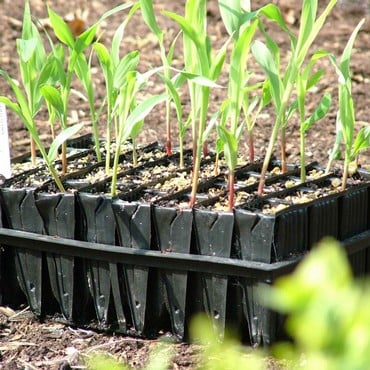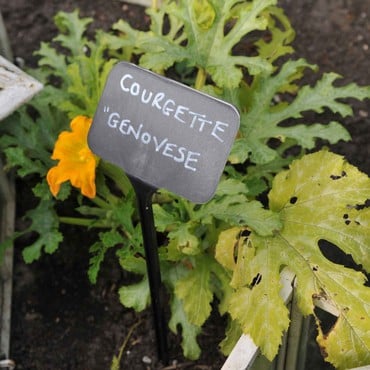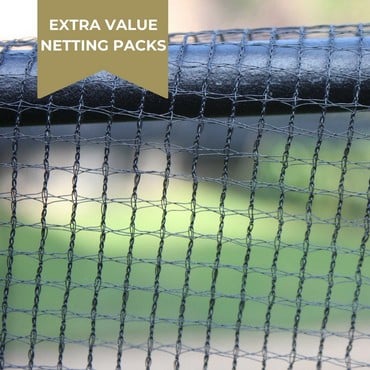June is here and summer is well and truly on it's way! Everything in the garden/allotment has suddenly shot up and at times keeping up with your to-do list can seem overwhelming! So, here's Ben Thornton's (aka The Young Grower) allotment advice for June...
Keep Picking Sweet Peas for a Longer Harvest
The more you pick, the more they grow. By removing flowers regularly, you make the plant think it has not yet produced the flowers that will eventually turn to seed giving you a longer harvest of beautiful sweet peas. Your sweet peas will also benefit from a weekly feed. I use Natural Grower to provide those much-needed nutrients for a bumper harvest.
What Can Be Sown This Month
This month there is a vast amount of produce that can be grown from seed. I'm going to give you a list of some of the seeds that you can sow now either directly into the ground or in a greenhouse.
Vegetables: Beetroot, Beans, Carrots, Chicory, Lettuce, Kale, Kohlrabi, Salad Leaves, Spring Onions, Broccoli, Turnip, Florence Fennel, Peas, Cucumber, Radish, Potatoes, Chard, Courgette, Perpetual Spinach
Flowers: Calendula, Nasturtium, Sunflowers, Wall Flowers, Fox Gloves, Lupins, Delphiniums, Aquilegia, Cornflower, Cosmos, Marigolds, Nigella
Herbs: Basil, Rosemary, Coriander, Dill, Parsley, Fennel, Chives

Building supports for climbing beans
When it comes to building supports for my climbing beans, I'm always very hesitant on where to build them meaning it’s one of the last jobs I do when it comes to planning my kitchen garden. I grow mine up canes using a plastic disc holder to keep them in place or I have also used twine to bind them together. Additionally, I grow mine up arches along with my squash.
This season I am growing 3 different climbing beans that produce different types of beans: ‘Blauhilde’ is a French climbing bean, ‘Scarlett Emperor’ is a traditional runner bean and ‘Greek Gigantes’ is a rare runner bean that has been bred over hundreds of years for its humungous buttery beans that are fantastic in stews and soups.
Protect Crops from Birds and Wildlife with Netting
There’s nothing worse than going into the garden to discover the birds and other wildlife have destroyed your crop. I recommend using a strong, durable netting like scaffolding netting as this prevents birds from getting trapped. If you plan to cover a crop that needs help from wildlife to pollinate, it would be best to use a netting with larger holes.
I have created a PolyCage to keep my Brassica crops protected from the hungry pigeons by using a polytunnel frame and netting it with garden scaffolding netting. This gave me the perfect growing area. Due to my disability, I needed raised beds and I came up with a ‘U’ shaped bed that is perfect for my needs. The raised bed gave me the perfect location to attach the netting.
Harvesting First Early Potatoes
When it comes to knowing when the time has come harvest, I like to go by how many weeks they have been planted. For example, first earlies take 10 to 12 weeks on average to grow. When the leaves start to die back, that is the sign it is harvest time. I always wait a minimum of 10 weeks before harvesting.
You can also plant more potatoes for an extended harvest, as well as growing Christmas potatoes. I get mine from Potato House who have a vast selection to choose from.
Here are some of the awesome varieties I am growing again this season:
- Salad Blue
- Red Emmalie
- Violetta
Regular Feeding is a Must
As the season continues, it is recommended that you regularly feed all your plants to give them those much-needed nutrients for an abundance of produce. My go-to high nutrient feed is from Natural Grower. This provides everything your plants need. You can use other plant feeds that will also do the job. Alternatively, you could make your own liquid feed using the resources you have available. Nettle and comfrey make the best homemade feed/tea that costs nothing but your time. Simply get a bucket with a lid and fill it up halfway with what you have growing, whether that is just nettle or comfrey on its own or a combination of the two. Once your bucket is half full, top the rest of the bucket up with water and place the lid on and leave. After 3-4 weeks you will have liquid gold to feed your plants. Dilute 1 part feed to 10 parts water. Please note this can get very, very smelly! I recommend that you make it out the way of where you sit and only use a bucket with a lid.
STOP! Slugs & Snails Before It’s Too Late…
Slug and snail season is upon us. If you are experiencing the same problem as I am, then you will know how much of a problem these hungry creatures are. They just don’t stop!
This year I am trying a couple of different methods. The one method I want to tell you about today is using sheep wool to keep your plants safe. It turns out slugs and snails hate wool with a vengeance. I have had great success with wool pellets, the only problem is I grow far too much to keep buying them. Thankfully, this year I’ve been using wool matting I recycled from a parcel I received. By putting it at the base of my delicate pants, it has gone a long way to protect them with amazing results. I’m also trying out a wildlife friendly slug and snail repellent from Grazers that masks the plant and makes it taste horrible for them to eat. So far, I have been impressed with the results.
There are many other methods you can use in your fight against these horrible slimy creatures. These are the two I use because they do not harm wildlife by taking away from the natural ecosystem that helps keep my plot under control!
Thanks for your time
Ben Thornton Aka The Young Grower
You can find Ben on Instagram, Facebook and YouTube or visit ben's website here.

































